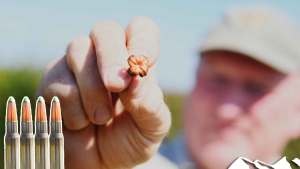In the 1990s, Andrew Venables was at a US gun show where a mini revolution was taking place. He had no idea at the time that the non-lead bullet Barnes was launching there would change his deer stalking.
He says it took about two years for the Barnes bullet to be exported to the UK and, when it was, he tried it out. When he did, he saw an immediate improvement in meat damage compared to the lead bullets he had been using.
It took time to get lead alternatives right. Lead-free rifle ammunition went through the same growing pains that shotgun cartridge manufacturers experienced with steel shot. “When steel shot for shotguns first came out, low-velocity, similar pellet sizes didn’t work as well as people expected. We’ve had a similar transitional period with non-lead ammunition,” says Andrew.
Non-lead bullets today include the Hornady GMX made from a gilding metal alloy, not pure copper. There are non-expanding bronze bullets unsuitable for hunting. There is a military and match round made of copper and tin compressed powder inside a copper jacket with a small hollow point. Andrew says: “When we fired a compressed copper and tin load into carcases, it disappeared inside into tiny fragments.”
One characteristic of copper is that you can fire it at the same speed as lead into a large, tough animal, such as a European red stag.. However, if you shoot a heavy copper bullet into a roe deer, which has less body mass, you can get both overly rapid penetration, less energy dump on the animal than you need, and you can get what Andrew calls “slightly delayed kills”.
To improve on that, instead of using a 150 or a 180-grain copper bullet in .308, Andrew has now gone to a 130-grain bullet. This travels at 3,000 feet per second and is still doing more than 2,600fps at 200 metres. “It gives you all the hydrostatic shock to kill and almost 100% weight retention.”
In .243, Andrew recommends an 80-grain bullet which causes an issue in Scotland where the law on bullet weights was designed around lead bullets. As a result, you have to use a minimum 100-grain bullet, whatever it is made from. An 80-grain bullet leaves the barrel at 3,350fps and gives, says Andrew, “good expansion expansion out to all sensible hunting ranges.”
“A light-for-calibre bullet is the way to go for people shooting foxes and varmints.”
That brings Andrew back to the gun show all those years ago. For now he recommends you try the Barnes Varmint Grenade. Andrew loads these in .223 WSSM and MV is an astonishing 4,000 feet per second.
“You have a bullet which takes very high velocity extremely well and, again, with a large hollow-point and compressed tin inside expands and disappears completely.”
Here is Barnes’ film of one of these rounds hitting a blueberry
Click here to go to the Fieldtester rifle ammunition front page
Also, have a look at these films with Andrew:



For more from Andrew, including his blog, visit the WMS Firearms Training website
For more from Fieldtester, visit Fcha.nl/fieldtester
Click here for more of our films with Andrew







